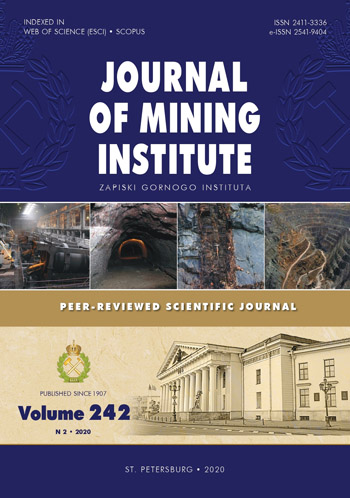Studies of enrichment of sulfide and oxidized ores of gold deposits of the Aldan shield
- 1 — Ph.D., Dr.Sci. Professor Irkutsk National Research Technical University ▪ Elibrary ▪ Scopus ▪ ResearcherID
- 2 — General Director Institute TOMS ▪ Elibrary ▪ Scopus
- 3 — Ph.D., Dr.Sci. Professor Irkutsk National Research Technical University ▪ Elibrary ▪ Scopus ▪ ResearcherID
- 4 — Ph.D. Associate Professor Irkutsk National Research Technical University ▪ Orcid ▪ Elibrary ▪ Scopus ▪ ResearcherID
Abstract
The paper presents the analysis of studies of the enrichment of sulfide and oxidized ores in Yakutia deposits. The ore of the deposit is a mixture of primary, mixed and oxidized ores. The main useful component of the studied ore samples is gold with a content of 1.5 to 2.8 g/t, the silver content is low – 5-17 g/t. Ore minerals are represented by sulfides, among which pyrite predominates. The total sulfide content does not exceed 3-5 %. The presence in the ore of free and associated gold with a grain size from fractions of a micron to 1.5 mm. Gold is represented by nuggets in intergrowth with sulfides and also forms independent inclusions. Ores are classified as easily cyanidable. It was found that the content of amalgamable gold is 10-49, the share of cyanidable gold ranges from 66.67-91, the share of refractory gold is 9.0-33.33 %, which in absolute amount equals to 0.24-0.8 g/t. The extraction of gold in gravitation concentrate varies depending on the gold content in the ore and the yield of concentrate and for ores with a gold content of 1.5-2.8 g/t from 40 to 60 %. The direct cyanidation of all studied ore samples established the possibility of extracting gold into solution up to 86.7-92.9 %, the gold content in cyanidation cakes is 0.2-0.3 g/t. Investigations of the gravitation concentrate by the method of intensive cyanidation showed that with an initial gold content of ~ 500 g/t, up to 98.9 % is extracted into the solution. The gold content in intensive cyanide cakes will be 6-15 g/t. A set of studies carried out by the authors of the article at various institutes showed that it is advisable to process ore from the deposit using cyanidation technology with preliminary gravitational extraction of gold.
